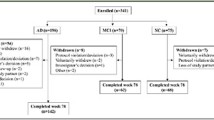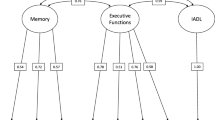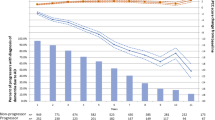Abstract
The Alzheimer’s Disease Neuroimaging Initiative (ADNI) measures abilities broadly related to executive function (EF), including WAIS-R Digit Symbol Substitution, Digit Span Backwards, Trails A and B, Category Fluency, and Clock Drawing. This study investigates whether a composite executive function measure based on these multiple indicators has better psychometric characteristics than the widely used individual components. We applied item response theory methods to 800 ADNI participants to derive an EF composite score (ADNI-EF) from the above measures. We then compared ADNI-EF with component measures in 390 longitudinally-followed participants with mild cognitive impairment (MCI) with respect to: (1) Ability to detect change over time; (2) Ability to predict conversion to dementia; (3) Strength of cross-sectional association with MRI-derived measures of structures involved in frontal systems, and (4) Strength of baseline association with cerebrospinal fluid (CSF) levels of amyloid β1-42, total tau, and phosphorylated tau181P. ADNI-EF showed the greatest change over time, followed closely by Category Fluency. ADNI-EF needed a 40 % smaller sample size to detect change. ADNI-EF was the strongest predictor of AD conversion. ADNI-EF was the only measure significantly associated with all the MRI regions, though other measures were more strongly associated in a few of the regions. ADNI-EF was associated with all the CSF measures. ADNI-EF appears to be a useful composite measure of EF in MCI, as good as or better than any of its composite parts. This study demonstrates an approach to developing a psychometrically sophisticated composite score from commonly-used tests.


Similar content being viewed by others
References
Alvarez, J. A., & Emory, E. (2006). Executive function and the frontal lobes: a meta-analytic review. Neuropsychology Review, 16(1), 17–42. doi:10.1007/s11065-006-9002-x.
Baker, F. B., & Kim, S.-H. (2004). Item response theory: Parameter estimation techniques (2nd ed.). New York: CRC Press.
Cahn-Weiner, D. A., Boyle, P. A., & Malloy, P. F. (2002). Tests of executive function predict instrumental activities of daily living in community-dwelling older individuals. Applied Neuropsychology, 9(3), 187–191. doi:10.1207/S15324826AN0903_8.
Cardenas, V. A., Chao, L. L., Studholme, C., Yaffe, K., Miller, B. L., Madison, C., et al. (2011). Brain atrophy associated with baseline and longitudinal measures of cognition. Neurobiology of Aging, 32(4), 572–580. doi:10.1016/j.neurobiolaging.2009.04.011.
Carmichael, O., Mungas, D., Beckett, L., Harvey, D., Tomaszewski Farias, S., Reed, B., et al. (2010). MRI predictors of cognitive change in a diverse and carefully characterized elderly population. Neurobiology of Aging. doi:10.1016/j.neurobiolaging.2010.01.021.
Carmichael, O., Schwarz, C., Drucker, D., Fletcher, E., Harvey, D., Beckett, L., et al. (2010). Longitudinal changes in white matter disease and cognition in the first year of the Alzheimer disease neuroimaging initiative. Archives of Neurology, 67(11), 1370–1378. doi:10.1001/archneurol.2010.284.
Chang, Y. L., Jacobson, M. W., Fennema-Notestine, C., Hagler, D. J., Jr., Jennings, R. G., Dale, A. M., et al. (2010). Level of executive function influences verbal memory in amnestic mild cognitive impairment and predicts prefrontal and posterior cingulate thickness. Cerebral Cortex, 20(6), 1305–1313. doi:10.1093/cercor/bhp192.
Crane, P. K., Narasimhalu, K., Gibbons, L. E., Pedraza, O., Mehta, K. M., Tang, Y., et al. (2008). Composite scores for executive function items: demographic heterogeneity and relationships with quantitative magnetic resonance imaging. Journal of the International Neuropsychological Society: JINS, 14(5), 746–59. doi:10.1017/S1355617708081162.
De Meyer, G., Shapiro, F., Vanderstichele, H., Vanmechelen, E., Engelborghs, S., De Deyn, P. P., et al. (2010). Diagnosis-independent Alzheimer disease biomarker signature in cognitively normal elderly people. Archives of Neurology, 67(8), 949–956. doi:10.1001/archneurol.2010.179.
Ewers, M., Walsh, C., Trojanowski, J. Q., Shaw, L. M., Petersen, R. C., Jack, C. R., Jr., et al. (2010). Prediction of conversion from mild cognitive impairment to Alzheimer’s disease dementia based upon biomarkers and neuropsychological test performance. Neurobiology of Aging. doi:10.1016/j.neurobiolaging.2010.10.019.
Farias, S. T., Mungas, D., Reed, B. R., Harvey, D., & DeCarli, C. (2009). Progression of mild cognitive impairment to dementia in clinic- vs community-based cohorts. Archives of Neurology, 66(9), 1151–1157. doi:10.1001/archneurol.2009.106.
Farias, S. T., Mungas, D., Reed, B., Carmichael, O., Beckett, L., Harvey, D., et al. (2011). Maximal brain size remains an important predictor of cognition in old age, independent of current brain pathology. Neurobiology of Aging. doi:10.1016/j.neurobiolaging.2011.03.017.
Gomar, J. J., Bobes-Bascaran, M. T., Conejero-Goldberg, C., Davies, P., & Goldberg, T. E. (2011). Utility of combinations of biomarkers, cognitive markers, and risk factors to predict conversion from mild cognitive impairment to Alzheimer disease in patients in the Alzheimer’s disease neuroimaging initiative. Archives of General Psychiatry, 68(9), 961–969. doi:10.1001/archgenpsychiatry.2011.96.
Goodglass, H., & Kaplan, D. (1983). The assessment of aphasia and related disorders (2nd ed.). Philadelphia: Lea & Febiger.
Grambaite, R., Selnes, P., Reinvang, I., Aarsland, D., Hessen, E., Gjerstad, L., et al. (2011). Executive Dysfunction in Mild Cognitive Impairment is Associated with Changes in Frontal and Cingulate White Matter Tracts. Journal of Alzheimer’s Disease: JAD. doi:10.3233/JAD-2011-110290.
Jack, C. R., Jr., Bernstein, M. A., Fox, N. C., Thompson, P., Alexander, G., Harvey, D., et al. (2008). The Alzheimer's Disease Neuroimaging Initiative (ADNI): MRI methods. J Magn Reson Imaging, 27(4), 685–691. doi:10.1002/jmri.21049.
Jack, C. R., Jr., Knopman, D. S., Jagust, W. J., Shaw, L. M., Aisen, P. S., Weiner, M. W., et al. (2010). Hypothetical model of dynamic biomarkers of the Alzheimer’s pathological cascade. Lancet Neurology, 9(1), 119–128. doi:10.1016/S1474-4422(09)70299-6.
Li, Y., Bolt, D. M., & Fu, J. (2006). A comparison of alternative models for testlets. Applied Psychological Measurement, 30(1), 3–21.
Llano, D. A., Laforet, G., & Devanarayan, V. (2011). Derivation of a new ADAS-cog composite using tree-based multivariate analysis: prediction of conversion from mild cognitive impairment to Alzheimer disease. Alzheimer Disease and Associated Disorders, 25(1), 73–84. doi:10.1097/WAD.0b013e3181f5b8d8.
Marra, C., Ferraccioli, M., Vita, M. G., Quaranta, D., & Gainotti, G. (2011). Patterns of cognitive decline and rates of conversion to dementia in patients with degenerative and vascular forms of MCI. Current Alzheimer Research, 8(1), 24–31.
McDonald, R. P. (1999). Test theory: a unified treatment. Mahwah: Lawrence Erlbaum.
McDonald, C. R., Gharapetian, L., McEvoy, L. K., Fennema-Notestine, C., Hagler, D. J., Jr., Holland, D., et al. (2010). Relationship between regional atrophy rates and cognitive decline in mild cognitive impairment. Neurobiology of Aging. doi:10.1016/j.neurobiolaging.2010.03.015.
Miyake, A., Friedman, N. P., Emerson, M. J., Witzki, A. H., Howerter, A., & Wager, T. D. (2000). The unity and diversity of executive functions and their contributions to complex “Frontal Lobe” tasks: a latent variable analysis. Cognit Psychol, 41(1), 49–100.
Mohs, R. C., Knopman, D., Petersen, R. C., Ferris, S. H., Ernesto, C., Grundman, M., et al. (1997). Development of cognitive instruments for use in clinical trials of antidementia drugs: additions to the Alzheimer’s Disease Assessment Scale that broaden its scope. The Alzheimer’s Disease Cooperative Study. Alzheimer Disease and Associated Disorders, 11(Suppl 2), S13–21.
Morris, J. C., Heyman, A., Mohs, R. C., Hughes, J. P., van Belle, G., Fillenbaum, G., et al. (1989). The Consortium to Establish a Registry for Alzheimer’s Disease (CERAD). Part I. Clinical and neuropsychological assessment of Alzheimer’s disease. Neurology, 39(9), 1159–1165.
Mungas, D., Harvey, D., Reed, B. R., Jagust, W. J., DeCarli, C., Beckett, L., et al. (2005). Longitudinal volumetric MRI change and rate of cognitive decline. Neurology, 65(4), 565–571. doi:10.1212/01.wnl.0000172913.88973.0d.
Mungas, D., Beckett, L., Harvey, D., Farias, S. T., Reed, B., Carmichael, O., et al. (2010). Heterogeneity of cognitive trajectories in diverse older persons. Psychology and Aging, 25(3), 606–619. doi:10.1037/a0019502.
Muthén, L. K., & Muthén, B. O. (1998–2007). Mplus: statistical analysis with latent variables. (5.1 ed.). Los Angeles, CA: Muthén & Muthén.
Nordlund, A., Rolstad, S., Klang, O., Lind, K., Pedersen, M., Blennow, K., et al. (2008). Episodic memory and speed/attention deficits are associated with Alzheimer-typical CSF abnormalities in MCI. Journal of the International Neuropsychological Society: JINS, 14(4), 582–590. doi:10.1017/S135561770808079X.
Nordlund, A., Rolstad, S., Gothlin, M., Edman, A., Hansen, S., & Wallin, A. (2010). Cognitive profiles of incipient dementia in the Goteborg MCI study. Dementia and Geriatric Cognitive Disorders, 30(5), 403–410. doi:10.1159/000321352.
Parks, C. M., Iosif, A. M., Farias, S., Reed, B., Mungas, D., & DeCarli, C. (2011). Executive function mediates effects of white matter hyperintensities on episodic memory. Neuropsychologia, 49(10), 2817–2824. doi:10.1016/j.neuropsychologia.2011.06.003.
Petersen, R. C., Aisen, P. S., Beckett, L. A., Donohue, M. C., Gamst, A. C., Harvey, D. J., et al. (2010). Alzheimer’s Disease Neuroimaging Initiative (ADNI): clinical characterization. Neurology, 74(3), 201–209. doi:10.1212/WNL.0b013e3181cb3e25.
Reeve, B. B., Hays, R. D., Bjorner, J. B., Cook, K. F., Crane, P. K., Teresi, J. A., et al. (2007). Psychometric evaluation and calibration of health-related quality of life item banks: plans for the Patient-Reported Outcomes Measurement Information System (PROMIS). Medical Care, 45(5 Suppl 1), S22–31.
Reitan, R. M., & Wolfson, D. (1985). The Halstead-Reitan neuropsychological test battery. Tucson: Neuropsychology Press.
Rolstad, S., Berg, A. I., Bjerke, M., Blennow, K., Johansson, B., Zetterberg, H., et al. (2011). Amyloid-beta is associated with cognitive impairment in healthy elderly and subjective cognitive impairment. Journal of Alzheimer’s Disease: JAD, 26(1), 135–142. doi:10.3233/JAD-2011-110038.
Salthouse, T. A. (2005). Relations between cognitive abilities and measures of executive functioning. Neuropsychology, 19(4), 532–545.
Schwarz, C., Fletcher, E., DeCarli, C., & Carmichael, O. (2009). Fully-automated white matter hyperintensity detection with anatomical prior knowledge and without FLAIR. Information Processing in Medical Imaging, 21, 239–251.
Shaw, L. M., Vanderstichele, H., Knapik-Czajka, M., Clark, C. M., Aisen, P. S., Petersen, R. C., et al. (2009). Cerebrospinal fluid biomarker signature in Alzheimer’s disease neuroimaging initiative subjects. Annals of Neurology, 65(4), 403–413. doi:10.1002/ana.21610.
Smith, E. E., Salat, D. H., Jeng, J., McCreary, C. R., Fischl, B., Schmahmann, J. D., et al. (2011). Correlations between MRI white matter lesion location and executive function and episodic memory. Neurology, 76(17), 1492–1499. doi:10.1212/WNL.0b013e318217e7c8.
StataCorp. (2011). Stata statistical software: release 12. College Station: StataCorp LP.
Tabert, M. H., Manly, J. J., Liu, X., Pelton, G. H., Rosenblum, S., Jacobs, M., et al. (2006). Neuropsychological prediction of conversion to Alzheimer disease in patients with mild cognitive impairment. Archives of General Psychiatry, 63(8), 916–924. doi:10.1001/archpsyc.63.8.916.
Trojanowski, J. Q., Vandeerstichele, H., Korecka, M., Clark, C. M., Aisen, P. S., Petersen, R. C., et al. (2010). Update on the biomarker core of the Alzheimer’s Disease Neuroimaging Initiative subjects. Alzheimer’s & Dementia: The Journal of the Alzheimer’s Association, 6(3), 230–238. doi:10.1016/j.jalz.2010.03.008.
Wainer, H., Bradlow, E. T., & Wang, X. (2007). Testlet response theory and its applications. NY: Cambridge UP.
Wechsler, D. (1981). Wechsler adult intelligence scale-revised. San Antonio: Psychological Corporation.
Wechsler, D. (1987). Wechsler memory scale-revised. San Antonio: Psychological Corporation.
Acknowledgments
Els Coart and Hugo Vanderstichele provided data classifying ADNI subjects by the CSF-based AD signature of de Meyer et al. (2010).
Elizabeth Sanders made Fig. 1 and assisted with manuscript preparation.
Supported by grants R01 AG 029672 (P Crane), P50 AG05136 (Raskind), and R13 AG030995 (Mungas) from the National Institute on Aging, and K08MH081065 (Mackin) from the National Institute of Mental Health.
Data collection and sharing for this project was funded by the Alzheimer’s Disease Neuroimaging Initiative (ADNI) (National Institutes of Health Grant U01 AG024904). ADNI is funded by the National Institute on Aging, the National Institute of Biomedical Imaging and Bioengineering, and through generous contributions from the following: Abbott; Alzheimer’s Association; Alzheimer’s Drug Discovery Foundation; Amorfix Life Sciences Ltd.; AstraZeneca; Bayer HealthCare; BioClinica, Inc.; Biogen Idec Inc.; Bristol-Myers Squibb Company; Eisai Inc.; Elan Pharmaceuticals Inc.; Eli Lilly and Company; F. Hoffmann-La Roche Ltd and its affiliated company Genentech, Inc.; GE Healthcare; Innogenetics, N.V.; Janssen Alzheimer Immunotherapy Research & Development, LLC.; Johnson & Johnson Pharmaceutical Research & Development LLC.; Medpace, Inc.; Merck & Co., Inc.; Meso Scale Diagnostics, LLC.; Novartis Pharmaceuticals Corporation; Pfizer Inc.; Servier; Synarc Inc.; and Takeda Pharmaceutical Company. The Canadian Institutes of Health Research is providing funds to support ADNI clinical sites in Canada. Private sector contributions are facilitated by the Foundation for the National Institutes of Health (www.fnih.org). The grantee organization is the Northern California Institute for Research and Education, and the study is coordinated by the Alzheimer’s Disease Cooperative Study at the University of California, San Diego. ADNI data are disseminated by the Laboratory of Neuro Imaging at the University of California, Los Angeles. This research was also supported by NIH grants P30 AG010129, K01 AG030514, and the Dana Foundation.
Conflict of interest
The authors declare that they have no conflict of interest.
Author information
Authors and Affiliations
Consortia
Corresponding author
Additional information
Data used in preparation of this article were obtained from the Alzheimer’s Disease Neuroimaging Initiative (ADNI) database (adni.loni.ucla.edu). As such, the investigators within the ADNI contributed to the design and implementation of ADNI and/or provided data but did not participate in analysis or writing of this report. A complete listing of ADNI investigators can be found at: http://adni.loni.ucla.edu/research/active-investigators/
Electronic supplementary material
Below is the link to the electronic supplementary material.
Online Appendix 1
(PDF 28 kb)
Online Appendix 2
(PDF 22 kb)
Online Appendix 3
(PDF 82 kb)
Rights and permissions
About this article
Cite this article
Gibbons, L.E., Carle, A.C., Mackin, R.S. et al. A composite score for executive functioning, validated in Alzheimer’s Disease Neuroimaging Initiative (ADNI) participants with baseline mild cognitive impairment. Brain Imaging and Behavior 6, 517–527 (2012). https://doi.org/10.1007/s11682-012-9176-1
Published:
Issue Date:
DOI: https://doi.org/10.1007/s11682-012-9176-1




